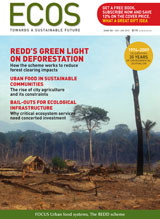
|
Published:
Nation-building 2.0: investing in ecological infrastructure
Concerted ‘bailout’ investment in ecological infrastructure and its connectivity will essentially underpin our future prosperity and is long-term insurance.

|
|
Bridge over the Murray River at Albury, NSW. Human and natural infrastructure need investment in order to work better together. Credit: Willem van Aken, CSIRO
|
As the global financial crisis hit its peak in October 2008, investing in built infrastructure became a key component of the world’s largest fiscal stimulus packages and figured in the responses of 30 out of 34 countries. Billions of dollars have been pledged to upgrade transport links, enhance education and health infrastructure and build communications systems.
Meanwhile, a chief concern of many scientists and environmentalists has been a lack of investment in the fundamental element of humanity’s economic prosperity: the trillions of dollars worth of ecosystem services that are critical to the functioning of the Earth’s life-support system.
In a ground-breaking 1997 Nature article,1 Professor Robert Constanza and his team revealed that ecological systems and their services make an immense contribution to human welfare, both directly and indirectly. The economic value of the entire biosphere (most of which was outside ‘the market’) was estimated to be in the range of US$16–54 trillion (1012) per year, at an average of US$33 trillion per year.
With global gross national product totalling only US$18 trillion in 1997, Professor Costanza’s article concluded that if the provision of these services was not given ‘adequate weight in the decision-making process, current and continued future human welfare may drastically suffer’.
These highly valuable services were popularised and their definitions formalised by the United Nations 2004 Millennium Ecosystem Assessment, a four-year study involving more than 1300 scientists worldwide. The study grouped ecosystem services into four broad categories: provisioning, e.g. the production of food and water; regulating, e.g. the control of climate and disease; supporting, e.g. nutrient cycles and crop pollination; and cultural, e.g. spiritual and recreational benefits.
The assessment found that 60 per cent of the ecosystem services that support life on Earth are being degraded or used unsustainably.
Five years have now passed, yet economic advisors and other policy-makers remain reluctant to ‘internalise’ environmental services and assets on the world’s balance sheet.

|
|
Hinchinbrook Island, channel and mangroves, as seen from a lookout near Cardwell, QLD. Credit: Willem van Aken, CSIRO
|
The lack of motivation for a ‘global environmental stimulus package’ is, according to CSIRO senior principal research scientist Dr Keith Bristow,2 due to a misconception about the nature of ecological infrastructure.
Dr Bristow and PhD student Steve Marchant3 are currently developing a framework for investing in ecological infrastructure.
Dr Bristow defines ecological infrastructure as an underlying framework that includes landscape components, ecosystems, their services and the interconnections within and between them.
‘The key aspect of this concept of ‘an underlying framework’ is that of connectivity,’ Dr Bristow says.
‘Just as human infrastructure is purposefully interconnected for maximum service effectiveness – like hospitals, roads and communications infrastructure – ecological infrastructure also requires a certain type and level of connectivity to sustain the environmental services that all living organisms and society depend on,’ he says.
Dr Bristow points out that while rivers, forests and wetlands are easily recognised, the ecological infrastructure is not visible in its entirety because many of the crucial interconnections are not obvious, or unknown.
‘Ecological infrastructure is then viewed as largely valueless – so it has been dismantled and degraded at a rapid rate,’ Dr Bristow says.
Our ability to disassemble natural connectivity is increasing and he points to the Murray–Darling Basin as a classic example of a degrading ecological infrastructure with an associated loss of vital ecosystem services.
‘Evidence of a deteriorating ecological infrastructure will include increased salinity, acid soils, nutrient pollution, carbon depletion, changing patterns of runoff, recharge and river flow, and declining connectivity between floodplains and streams,’ Dr Bristow says.
He argues for a new approach to human development simply because ‘continued global socio-economic development will ultimately depend on how well we can integrate our built infrastructure with and within a viable and resilient ecological infrastructure.
‘When you look at current trends in population growth and living standards, you realise that we will be expecting our ecological infrastructure to provide even more ecosystem services in the future. Business-as-usual, which involves little investment in ecological infrastructure, is not an option,’ Dr Bristow says.
He says nation-building must include investments aimed at restoring degrading ecological infrastructure and maintaining the resilience and regenerative capacity of ‘undisturbed’ ecological infrastructure in the case of future developments.
‘We also have to find a way of enhancing the capacity of ecological infrastructure – strengthening the vital links and enhancing resilience – if we continue to place ever-increasing demands upon it.’
Professor Gene Likens, of New York’s Cary Institute of Ecosystem Studies, who in the early 1960s was among the first to link the increasing acidity in rain with the burning of fossil fuels, agrees with Dr Bristow’s assessment that investing in this area has to be as forthcoming as the current economic recovery solutions.
‘Application of both ecological knowledge and an ecological approach is central to intelligent use and management of aquatic resources. Investing in ecological structure needs to be swift and significant,’ Dr Likens says.
More information:
Millennium Ecosystem Assessment (MEA) (2005) Ecosystems and Human Well-Being: Synthesis. Island Press, Washington.
1 Costanza R, d’Arge R, de Groot R, Farber S, Grasso M, Hannon B, Limburg K, Naeem S, O’Neill RV, Paruelo J, Raskin RG, Sutton P and van den Belt M (1997) The value of the world’s ecosystem services and natural capital. Nature 387, 253–260.
2 CSIRO Land and Water and the CRC for Irrigation Futures.
3 Steve Marchant is working on this topic of ‘investing in ecological infrastructure’ for his PhD thesis, based with CSIRO Land and Water, registered through the University of Queensland and funded by the CRC for Irrigation Futures.



